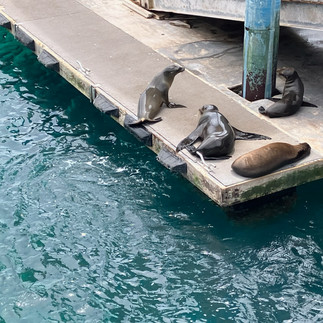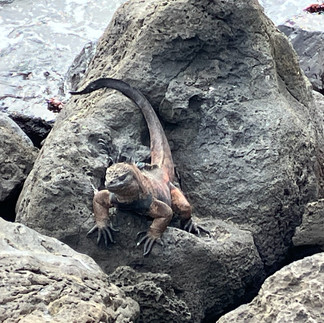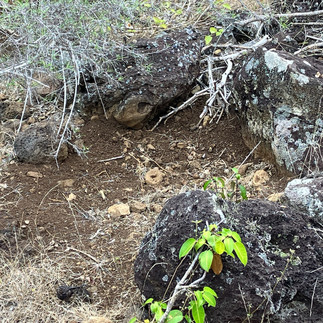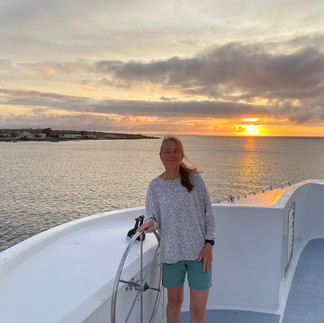Rising early, we breezed through Quito rush hour, despite road closures, with just enough time to finish my coffee and packed breakfast. Kids in school uniform everywhere! Quito schools are mandatory and free to 14; further education and university, like anywhere, are expensive. We also spotted the rose farms, where most of our supermarket roses originate apparently.
All became clear as we cleared the Galapagos security, checked bags, and boarded the plane, regarding the elusive third person on our booking. A lovely Australian gentleman travelling since his wife died, will join us on the same cruise.
Remaining on board as our flight stopped in Guayaquil, we spotted the shrimp farms amidst the massive urban sprawl; another million or so more people than Quito have to live somewhere!
Rather too much blue thankfully became purple and green heather and a tarmac runway, as we landed. Turning at the end of the runway we headed to civilisation at San Cristóbal airport. Sniffer dogs, bags x-rayed for banned substances and park entrance secured; we were in! Again tourists are controlled, we must be with a guide with a 120 people on any one trail.
A short bus ride, zodiac jaunt - on a different tender to Simon and we reached our boat the Treasure of Galapagos. Our cabin is enormous with a balcony on each side. We are joined by a father and daughter, and two other couples, plus the elderly gentleman.
After lunch we took the zod back to town, photographing the marine iguanas sunning themselves, whilst sally light foot crabs scuttle about and watching the sea lions (lobo del mar) argue, swim, and deal with child care! (a mum scolded her 2 week old pup, dragging him off by the scruff of his neck!)
I could have watched them all afternoon, however the bus arrived for our trip to see the tortugas terrestres, tortoises at the David Rodrigues breeding centre on SE side near mount cerro colorado, built to help save the giant tortoise (Chelonoidis chathamensis) founded in 1959. We saw many females and a few babies, mocking birds, finches and a poisonous tree -extremely toxic to humans.
Back at the port in San Cristóbal, fridge magnet for Ecuador secured, we strolled along the seafront watching more sea lions and the sunset. After our briefing for the tomorrow and mandatory life boat drill we had a lovely dinner. Then the excitement got the better of me and I retired!
Arriving in the Galapagos: San Cristóbal
(Airport; sniffer dog; pier; Simon's zodiac launch; Treasure of the Galapagos; coast guard!)
First sighting of animals on the pier
(Sea lions/lobo del mar; marine iguanas & sally light foot crabs; sea lion pup 2weeks; sea lions; marine iguana)
David Rodrigues breeding centre for giant tortoises
(sign; manzanillo or poison apple very acidic poisonous to humans; Chelonoidis chathamensis giant tortoise; mud hole, mud acts like insect repellent for tortoises!; giant tortoise; breeding pen with babies; mocking bird unique to San Christobel; tortoise showing saddle back; tortoise poop; more tortoises; Spanish moss & lichen Spanish symbiotic relation with tree keeping it moist)
Seafront San Cristóbal
(Seafront; sign; Sea lions on the beach; on launch ; sunset from observation deck on Treasure)
Some of Simon's photos
Just to prove I was listening today!!!
Spanish priests leaving Panama for Peru, whilst stuck in the doldrums, discovered the Galápagos Islands, in the name of the Spanish king. Claiming the island contained only ugly animals... iguanas, booby blue feet, tortoises sea lions. The lava rock island is a saddle back shape hence the name Golapagos. With no precious metals, gold silver or really space to farm, they left in 1561.
Later by 1635 the Spanish returned and the islands became popular with pirates, looking for food. The slow giant tortoises can go for upto 1 year without food! They taste like chicken apparently! Sadly the pirates brought dogs, cats, rats, horses and mules, with them. Many escaped becoming feral, now endemic to the islands these animals along with human consumption devestated the tortoises population eating the young. Over 500k tortoises we're killed from 15 th century its estimated! Over 14 species dominated the islands identified by their shells, not many are left.
Darwin loved to eat exotic animals, apparently he took 28 on his last voyage; most died, however 3 made it; 1 in Australia and 2 in England, of which one is still alive!
in 1971 the breeding program to recover the population started. It takes 6-8 hours for tortoises to mate. At the breeding centre they take the freshly laid eggs (size of a tennis ball) marking their location. They separate into male and female groups 1:3 ratio. Gender is temperature related 29.5'C hatches to female, 28 'C to male. The eggs hatch in dark conditions. After a month they put them in the breeding pens for 2 years feeding 3 times a week, to allow their keratin shells to harden. After 5 years they are tough enough to survive on the islands and are returned to where they were originally found. Males tend to be two to three times larger than females.
Only people from the Galapagos can live on the islands. Tourists can stay up to three months in a year, whilst foreigners can only work on a sponsored visa for 1 year (renewable 4times). Only four out of the thirteen major islands with humans! San Cristóbal, Santa Cruz, Floreana and Isobela.
We stayed at Treasure of Galapagos catamaran boarded at San Cristóbal Ecuador



































































Comentarios